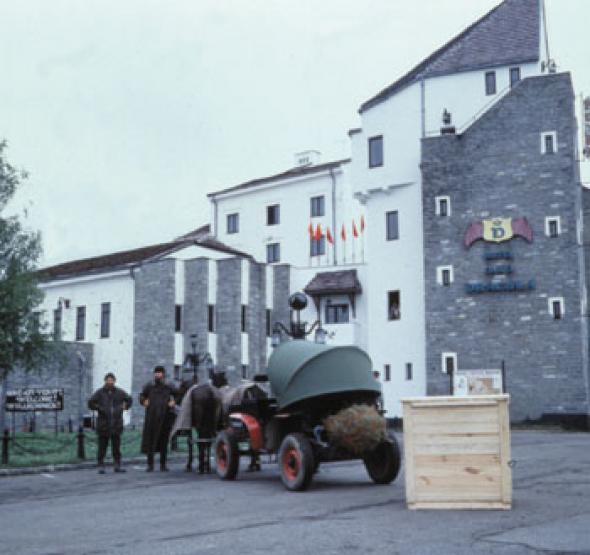Boxing the Issue in
JJ Charlesworth on the artworld’s crucifix-and-garlic response to the Austrian Situation
The question of art’s engagement with politics is always a vexed one, even though no one argues (or at least not convincingly) that political implication is both passively inevitable and actively necessary. The substantial question over politics in art is rarely if art should attempt to be political, but always what politics art should promote and how art’s forms and functions facilitate or inhibit that objective.
Roman Vasseur’s ongoing installation ‘500 Pounds of Common Earth, 1 metre cubed, Transylvania to London, 1999-’ at the Austrian Cultural Institute has become a case in point. The box of Transylvanian earth is political only in the implicit acknowledgement of the politicised nature of its journey. Its passage from Dracula’s Borgo Pass via Austria into the EU was marked by the bureaucratic obstacles and absurdities of ‘Fortress Europe’. After the business of acquiring its ‘phyto-sanitary certificate’ the box effectively vanished; having passed unnoticed by EU customs controls it was, once in the EU, deemed non-existent for lack of the correct paperwork.
But fine as Vasseur’s elegant ironies were, the breadth of interpretation they allowed was inevitably drowned by the contradictory moral demands of the context in which they were presented. Writing in Art Monthly, the Austrian Cultural Institute’s curator Anthony Auerbach (who had suspended his planned programme and brought in Vasseur’s project after the Freedom Party’s rise to power) declared that it “was not going to be my business to protect Austrian institutions from the consequences of Austrian party politics.” This was only a small part of the broader outcry at the Austrian election results, an outcry which, although predictable enough in an age of official anti-racism and multiculturalism, did little to encourage a better understanding of the Austrian situation, and actively repressed the more substantial questions at stake. For though it is indeed worrying that 27% of Austrian voters should side with an openly xenophobic party, the Freedom Party’s success has a lot more to do with the stagnation of the post-war carve-up of Austrian politics than it does with any resurgent enthusiasm for neo-nazism.
Since the early 1950s, the social democrats of the Sozialdemokratische Partei Österreichs and the Christian democrats of the Österreichische Volkspartei have effectively divided between them every position of economic, political and administrative responsibility, in an unofficial arrangement know as the Proporz. The liberal pundits who flex their outrage at the surface racism of Haider’s odious party seem to forget that it was the SPÖ-ÖVP coalition that implemented, throughout the ‘90s, increasingly restrictive anti-immigrant measures, in a society in which was content to exclude immigrants under the handy formula of the ‘Gastarbeiter’ (guest-worker). Austria’s policies are unremarkable subordinates to the EU’s systematic anti-immigrant policy, a policy in which the British government fully plays its own part. We may all be anti-racists now, but multicultural Britain ends at the gates of Campsfield Detention Centre, and the tolerance of diversity falls short of the asphyxiated corpses pulled from the truck at Dover.
Perhaps the most elusive reading of Vasseur’s project is the one of which we should take most heed. Bram Stoker’s Dracula, so one interpretation goes, is a Victorian morality tale warning against the spread of syphilis, a disease of the blood like that passed on by the Count to his victims. Vasseur’s box may reveal Europe’s syphilitic fear of the outsider, and yet this may be read both ways. Whilst we may prefer to cast the racist and the xenophobe as the true outsider, this has led, as with the debacle over Austria, to a situation in which we unwittingly obscure the anti-immigrant policies of our own governments. In so doing, we risk isolating the majority of Austrians, including artists, in a chorus of self-righteous condemnation, while leaving the reality of an anti-immigrant Europe intact. For artists to make their political engagement anything other than second order, forever following in the wake of the current consensus, will require a more substantial consideration of what will constitute the radical art and politics of the new century.
JJ Charlesworth <jjcharlesworth AT cwcom.net>
Mute Books Orders
For Mute Books distribution contact Anagram Books
contact@anagrambooks.com
For online purchases visit anagrambooks.com








